 |
 |
| J Korean Acad Pediatr Dent > Volume 44(1); 2017 > Article |
|
초록
본 연구의 목적은 유동성 레진의 교합면 열구에서의 침투도와 미세누출을 평가하여 치면열구전색제로서의 사용 가능성을 규명해 보고자 하는데 있다.
발거된 120개 치아를 4개 군으로 분류하고 I군은 대조군으로 레진계 치면열구전색제로 전색, II군은 유동성 레진으로 전색, III군은 상아질접착제를 도포한 후 유동성 레진으로 전색, IV군은 열구성형술을 시행하고 상아질접착제를 도포한 후 유동성 레진으로 전색하여 열구 내로의 침투도와 미세누출을 비교 평가하고 주사전자현미경으로 침투 및 접착상태를 관찰하였다.
유동성 레진의 열구내 침투도나 미세누출은 레진계 전색제에 비해 낮게 나타났으나 상아질접착제를 도포하거나 열구성형술을 시행한 후 상아질접착제를 도포한 경우는 레진계 전색제와 침투도의 차이가 없었으며 미세누출은 더 작게 나타났다.
주사전자현미경상에서 열구의 형태나 열구성형술의 여부에 따라 침투도의 차이가 관찰되었으며 상아질접착제를 사용하지 않은 일부 유동성 레진 시편에서는 법랑질 표면과 긴밀한 접착이 이루어지지 않았다.
이상의 결과를 종합해보면 유동성 레진은 치면열구전색제로서의 적용이 가능하며 열구성형술과 상아질접착제를 사용한다면 침투도를 높이고 미세누출을 줄일 수 있을 것으로 사료된다.
Abstract
The aim of this study was to compared the penetration scores and microleakage levels of flowable resin in comparison to resin-based pit and fissure sealant.
A total 120 extracted premolars were used and classified with group I (resin-based pit and fissure sealant), group II (flowable resin), group III (bonding agent + flowable resin), IV (fissurotomy + bonding agent + flowable resin) depending on the materials and the application methods.
The penetration scores of the group treated with flowable resin following fissurotomy were similar to those of the group treated with resin-based sealant, but higher compared to those of the other groups treated with flowable resin without fissurotomy or bonding agent. The group treated with flowable resin following fissurotomy also exhibited the lowest microleakage levels. The group treated with resin-based sealant and the one treated with a bonding agent prior to the application of flowable resin showed similar microleakage levels. In conclusion, flowable resin may be applied as a pit and fissure sealant, and its application along with fissurotomy could increase the penetration scores.
치아 교합면의 소와 및 열구는 치아우식증이 호발하는 부위로 특히 소아 및 청소년에서 새로 맹출한 구치의 교합면은 석회화가 아직 완전히 이루어지지 않아 치아우식증에 대한 감수성이 매우 높다. 따라서 교합면 우식증은 조기진단과 예방의 필요성이 높은 우식증으로 과거 잇솔질이나 불소도포, 치면열구전색 등 여러 예방법이 소개되어 오고 있으나 그중에서도 치면열구전색술이 가장 효과적인 방법으로 인정받고 있다.
치면열구전색술의 치아우식증 예방 효과는 과거로부터 현재까지 여러 문헌에서 보고하고 있으며, 적용하는 재료와 도포방식 등 여러 요인에 의해 다소 차이가 있을 수 있지만 30 - 70%로 비교적 높게 평가되고 있다[1-3].
그러나 치면열구전색술의 치아우식증 예방 효과가 뛰어남에도 불구하고 아직도 유지력에 대한 문제점이 지속적으로 제기되고 있다. 이는 주로 치면열구전색제와 소와 및 열구 내면의 법랑질과의 긴밀한 접착이 이루어지지 않을 경우로 교합력이나 저작력에 의한 스트레스나 기계적 마모, 전색제의 중합수축이나 구강 내 온도변화에 따른 변연누출 등이 원인인 것으로 알려졌다[4,5]. 이러한 관점에서 치면열구전색제의 열구 내로의 침투와 접착력을 증가시키기 위해 현재까지 많은 연구들이 이루어지고 있다.
치면열구전색제의 접착력에 영향을 줄 수 있는 요인으로 교합면 열구의 기하학적 형태와 법랑질의 미세구조 등 구조적 요인, 열구 내 유기물 잔사 등의 환경적인 요인, 그리고 시술 중 타액오염, 산 부식 등 기술적인 측면을 들 수 있으며 이와 함께 재료적인 요인이 성공과 실패를 좌우하는 큰 요인으로 작용할 수 있다.
현재 대부분의 치면열구전색제는 레진을 기본성분으로 하고 있는데 주로 bisphenol A-glycidyl methacrylate (Bis-GMA)와 triethylene glycol dimethacrylate (TEGDMA)계의 모노머가 많이 사용된다. 근래에는 모노머에 filler를 첨가하여 마모저항성을 개선하고 중합수축을 줄여 미세누출을 개선하려는 노력이 이루어지고 있으나 열구내로의 침투력이 상대적으로 약해져 실제 효과가 있는지에 대한 논란이 있다[6,7]. 이와 함께 최근에는 불소를 함유하는 글래스아이오노머 시멘트를 주성분으로 하는 치면열구전색제들이 개발∙시판되고 있는데, 이는 산부식할 필요가 없어 방습이 어려운 어린이들에게 사용상의 편의성은 있으나 유지력이 좋지 않아 이에 따른 이차적인 우식의 발생과 탈락이 문제점으로 지적되고 있다[8,9].
최근에는 레진의 재료적인 발전과 함께 접착기술이 개선되어 치면열구전색술은 치아우식증 예방은 물론 나아가 최소삭제를 통한 최소침습치료(minimally invasive treatment)의 영역으로까지 확대되기에 이르렀다[10]. 최소침습치료의 개념이 점차적으로 보편화되면서 소와나 열구의 초기우식증을 와동 형성을 통한 수복이 아닌, 전색을 통한 밀봉으로 치료의 방식이 바뀌고 있어 치면열구전색술은 기술과 재료적인 면에서 한층 더 발전되어야 한다는 명제를 안게 되었다.
이와 같이 교합면 열구에서의 수복과 전색의 경계가 불분명하게 되면서 이 두 가지 술식을 동시에 만족시킬 수 있는 전색제로서 유동성 레진이 부각되고 있는데, 유동성 레진을 사용하여 우식성 열구의 수복과 함께 건전한 열구의 전색을 통한 치료와 예방 술식을 동시에 시행하고자 하는 시도가 늘고 있다.
유동성 레진이 치면열구전색제로 사용될 수 있는 타당성은 우선 점주도와 탄성계수(modulus of elasticity)가 낮아 흐름성이 좋고 중합수축시의 응력이 최소화되어 미세누출이 적다는 것이며 이와 함께 수복용 레진의 장점인 마모도 등의 물리적 특성이 좋다는 것이다[11,12].
Erdemir 등[13]은 인체 구강 내에서 좌우를 달리하여 한 편은 레진계 치면열구전색제를 다른 한 편은 유동성 레진을 도포한 후 24개월 동안 유지력을 평가한 결과 각각 85.4%와 85.5%로 차이가 없음을 보고하였다. 그외 다른 연구들에서도 레진계 치면열구전색제와 유동성 레진의 유지력이 비슷하다고 보고하였다[14,15]. 그러나 Autio-Gold [7]는 임상연구를 통하여 18개월 동안 46%의 필러를 함유한 유동성 레진을 레진계 치면열구전색제와 비교해 본 결과 더 낮은 유지력을 보였다고 보고하였으며 Oba 등[12]의 연구에서도 도포 2년 후 레진계 치면열구전색제의 유지력이 81.0%인데 비해 유동성 레진의 유지력은 57.1 - 60.5%로 더 낮다고 하였다. 그러나 이들이 사용한 유동성 레진은 다른 제품에 비해 필러의 함량이 상대적으로 높아 흐름성에 문제가 있을 수도 있다고 판단된다. 반면 Chaitra 등[16]은 유동성 레진을 열구성형술와 함께 전색을 시행한 경우 일반 레진계 치면열구전색제 보다 미세누출은 더 적고 레진 tag의 길이는 더 크다고 하였다.
이상에서 기술한 바와 같이 치아우식증 치료에 대한 패러다임이 변하면서 유동성 레진의 사용 범위는 점점 넓어지고 있으며 특히 치면열구전색제로서 사용이 증가되고 있지만 유동성 레진에 대한 교합면 열구에서의 전색효과를 평가한 연구는 많지 않다. 그중에서도 대부분의 연구가 임상연구로 기존의 레진계 치면열구전색제와 단순히 유지력만 비교하는데 국한되어 있으며 유동성 레진의 열구 내 침투도와 미세누출 등을 측정하여 전색효과를 정량적으로 평가한 연구는 거의 없다.
따라서 본 연구에서는 유동성 레진의 교합면 열구 전색상태를 열구내 침투도와 미세누출 정도를 통하여 정량적으로 평가하고 열구성형술을 접목한 도포방법이 유동성 레진의 전색 효과를 높일 수 있는지를 알아보고자 하고자 한다.
교정 목적으로 발거된 소구치를 대상으로 시진과 탐침을 통하여 충전물이나 파절 등 표면 결함이 없고, 교합면 우식증이 관찰되지 않은 치아를 선택한 후 치아우식증 진단기기인 DIAGNOdent® (Kavo, Germany)를 사용하여 치아우식증이 없다고 판단되는 수치(제조회사의 가이드라인에서 "13" 이하)에 해당되는 치아 120개를 선정하여 실험에 사용하였다. 치면열구전색을 위한 산 부식제는 35% 인산인 Ultra-Etch® (Dentsply, USA)를 사용하였고, 치면열구전색제는 레진계인 Clinpro® (3M-ESPE, USA), 유동성 레진은 Filtek® Flow (3M-ESPE, USA), 상아질접착제(bonding agent)로는 Adper® Single Bond Plus (3M ESPE, USA), 광중합기는 BeLite® LED 광중합기(B&L Biotec, Korea)를 사용하였다. 열구성형술을 위한 기구로는 끝이 뾰쪽한 12-fluted resin finishing bur (Komet, Germany)를 사용하였다. 모든 치아는 실험 전 불소가 포함되지 않은 퍼미스를 이용하여 치관부에 치면 세마를 시행하고 5% NaOCl에 담아 초음파 세척기에 1시간 동안 세척한 후 증류수로 재 세척하여 생리식염수에 보관하였다.
대상 치아를 30개씩 4개의 군으로 나누고 20초간 35% 인산으로 부식시켰으며 10초간 물을 분사하여 세척한 후 three way syringe의 압축공기를 이용하여 완전히 건조시켰다. 각 치아 시편은 다음과 같이 재료와 도포방법에 따라 I군은 대조군으로 설정하여 레진계 치면열구전색제(Clinpro®)로 전색하였으며, II, III, IV군은 실험군으로 설정하여 유동성 레진(Filtek® Flow)으로 전색하였다. 실험군중 II군은 아무런 전 처치 없이 유동성 레진으로 전색하였으며, III군은 상아질접착제를 도포한 후 유동성 레진으로 전색하였고, IV군은 열구성형술을 시행하고 상아질접착제를 도포한 후 유동성 레진으로 전색하였다(Table 1).
치면열구전색제에 대한 구강내 환경을 재현할 목적으로 중합이 완료된 모든 치아 시편들을 군 별로 30개씩 나누어 실온의 생리식염수에 24시간 동안 보관한 후, 5℃와 55℃의 수조에서 각각 30초씩 교대로 500회의 열 순환을 시행하였다. 색소 침투를 유도하기 전 치면열구전색제 이외에서 불필요한 색소 침투를 막기 위해 utility wax로 근단공을 폐쇄하고 전색제 변연의 1 mm를 제외한 치면 전체에 nail varnish를 도포하였다. 이후 시편들을 1% methylene blue 용액에 24시간 동안 담근 후 꺼내어 흐르는 물에 깨끗이 세척하고 여분의 색소와 utility wax를 제거하였다.
규격화된 원형의 주형에 치아 시편을 고정시키고 epoxy resin에 매몰시킨 뒤 Isomet low speed diamond wheel saw (Model 650, South Bay Technology, USA)을 이용하여 협설 방향으로 절단하여 열구의 수직 단면을 노출시키고 100 - 4000 grit의 silicon carbide paper로 연마하였다(Fig. 1). 노출된 절단면의 미세누출과 침투도는 입체현미경(Olympus SZ61®, Japan)을 이용하여 40배율로 관찰하였다.
열구내 법랑질 표면과 치면열구전색제의 계면으로 침투한 methylene blue 용액의 침투 깊이를 측정하였고 침투도 측정과 같은 기준에 의해 평가하였다(Fig. 3).
치면열구전색제의 열구 내 침투상태와 법랑질과의 접촉상태를 평가하기 위해 4개 그룹의 치아 시편 각 30개를 협설로 절단하여 열구의 단면을 노출시키고 주수 하에서 100 - 4000 grit의 silicon carbide paper로 연마하였다. 연마된 표면은 17% EDTA로 10초간 부식시킨 후 물로 15초간 세척하고 압축공기로 건조시켰다. 열구 단면의 미세구조를 관찰하기 위해 주사전자현미경(JEOL JSM-840A, JEOL Co., Japan)을 이용하였다. 시편들을 진공 데시게이터를 이용하여 충분히 건조시켜준 다음 2kV, 20mA의 전압과 4 × 10-2 bar/pa의 진공상태에서 Ion sputter (E-1030, Hitachi, Japan)를 이용하여 도금처리를 하였다. 열구는 입구, 벽, 기저부로 나누어 관찰하였다. 열구의 형태, 치면열구전색제의 침투도와 열구와의 접촉상태를 각각 관찰하였다.
각 군에 따른 치면열구전색술 시행 후 침투도는 통계적으로 유의한 차이가 있는 것으로 나타났다(Table 2). 모든 군 공히 열구 깊이의 1/2이상 침투하였으나 기저부까지는 침투하지 않은 score 2에 가장 많이 분포하였으며 다음으로 열구 깊이의 1/2이하로 침투한 score 1, 그리고 기저부까지 침투한 score 3순으로 분포하였다. 열구 입구로 흘러 들어가지 않은 score 0은 II군에서 1개 시편이 분포하였다.
각 침투도에 대한 군별 분포를 비교해 볼 때 score 1은 II군과 III군이 I군과 IV군에 비해 유의하게 많이 분포했으며(p < 0.05) score 2는 모든 군이 비슷하게 분포하였고 score 3은 IV군이 가장 많았으며(p < 0.05) I군이 II군에 비해 많았다(p < 0.05).
각 군별 침투도를 비교해 볼 때, 열구성형술을 시행하고 상아질접착제를 도포한 후 유동성 레진을 적용한 IV군이 다른 유동성 레진 도포군인 II군과 III군에 비해 침투도가 크게 나타났다(p < 0.05).
레진계 전색제인 I군이 상아질접착제를 사용하지 않은 유동성 레진 도포군인 II군에 비해 침투도가 크게 나타났으나(p < 0.05) 다른 유동성 레진 도포군인 III군과 IV군에 비해 침투도의 차이가 없었다(Fig. 4).
이상의 결과를 종합해 보면 열구성형술을 시행한 후 유동성 레진을 도포할 경우 열구성형술을 시행하지 않고 유동성 레진을 도포한 경우보다 침투도가 높으며 레진계 전색제와는 유사한 침투도를 보이는 것으로 나타났다.
각 군에 따른 미세누출의 차이는 통계적으로 유의한 차이가 있는 것 나타났다(Table 3). 각 군 공히 미세누출이 전혀 없는 score 0에 가장 많이 분포하였으며 다음으로 score 1, score 2순으로 분포하였다.
미세누출 정도에 따른 군별 분포를 비교해 볼 때 미세누출이 전혀 없는 score 0은 IV군에서 가장 많이 관찰되었으며 II군에서 가장 적게 관찰되었다(p < 0.05). 미세누출이 가장 많은 score 3은 IV군에서 관찰되지 않았으나 I군과 III군에 비해 통계적인 유의성은 없었다. 그러나 II군에 비해서는 유의한 차이를 보이고 있다(p < 0.05).
각 군별로 미세누출을 비교해 볼 때, 열구성형술을 시행하고 상아질접착제를 도포한 후 유동성 레진을 적용한 IV군이 다른 유동성 레진 도포군인 II군과 III군, 그리고 레진계 전색제를 도포한 I군에 비해 미세누출이 적게 나타났다(p < 0.05).
레진계 전색제를 도포한 I군과 상아질접착제를 적용한 후 유동성 레진을 도포한 III군은 상아질접착제를 사용하지 않고 유동성 레진만 도포한 II군에 비해 낮은 미세누출을 보였으나(p < 0.05) I군과 III군 사이에는 유의한 차이를 보이지 않았다(Fig. 5).
레진계 전색제인 I군의 시편들에서는 전반적으로 침투력이 좋고 열구 벽과 긴밀한 접촉을 보여주었으나 침투상태는 열구의 형태에 의해 영향을 받는 것으로 나타났다(Fig. 6).
상아질접착제를 사용하지 않고 유동성 레진을 도포한 II군에서는 대체적으로 침투력이 좋지 않고 열구벽과의 긴밀한 접촉을 보여주지 못한 표본이 많이 관찰되었다(Fig. 7). 상아질접착제를 사용하고 유동성 레진을 도포한 III군의 시편들에서는 침투력이 레진계 전색제와 비슷하게 나타났고 열구벽과의 접촉상태도 긴밀하였으나 열구의 형태에 의해 침투력에 영향을 받는 것으로 관찰되었다(Fig. 8).
열구성형술을 시행한 후 유동성 레진을 도포한 IV군의 경우 대체로 침투력이 우수하고 열구 벽과의 접촉상태도 긴밀하였으나 열구성형술이 충분히 이루어지지 않은 일부 시편에서는 침투가 만족스럽지 못한 경우도 관찰되어 열구성형술이 기술적으로 예민함을 보여주고 있다(Fig. 9).
치면열구전색제의 치아우식증 예방기능은 치면열구전색제가 적용된 후 탈락되지 않고 장기간 열구내의 치질과 결합하고 있을 경우에만 가능한데 이러한 치면열구전색 유지는 열구 입구에서 법랑질과 치면열구전색제의 결합력 뿐 아니라 열구 기저부까지의 침투정도에 영향을 받는다.
Lee [4]는 치면열구전색제의 열구 내로의 침투는 유지력을 위한 가장 중요한 요소라고 하였으며 근본적으로 열구의 해부학적 형태에 영향을 많이 받는다고 하였다. 보통 교합면 열구는 해부학적 형태에 따라 K형, I형, U형, V형 등 4가지로 분류되는데[18], 이중 K형이나 I형은 U형이나 V형에 비해 잇솔질에 의해 치태가 잘 제거되지 않으며 또한 치면열구전색제의 침투도 어렵다고 알려져 있다[19]. 본 연구에서도 주사전자현미경 관찰 소견에 따르면 열구의 해부학적 형태에 따라 치면열구전색제의 침투도가 많이 영향을 받는 것으로 나타났다.
근래에 수복치료 분야에서“예방적 확대”개념이 보존적인 수복의 개념으로 변화하면서“preventive resin restoration”이란 차원을 넘어 최소침습치료로의 접근이 이루어지고 있다[20].
이와 같은 관점에서 최근에 유동성 레진을 치면열구전색을 위해 사용하는 예가 늘고 있으며 일부 학자들은 적어도 얕고 넓은 열구에서는 유동성 레진이 레진 전색제의 침투도와 견줄만한 하다고 보고하고 있다[21,22].
따라서 본 연구에서는 치면열구전색 목적으로 사용이 점차 증가되고 있는 유동성 레진과 기존의 레진 전색제를 침투도 및 미세누출면에서 비교, 평가하고 이와 함께 열구성형술이 유동성 레진의 침투도에 미치는 영향을 평가하여 치면열구전색제로서의 사용 가능성을 규명하고자 하였다.
최근 치면열구전색제로 유동성 레진이나 컴포머를 사용하는 경우가 많아지고 있는데 Autio-Gold [7], Oba 등[12]은 전통적인 레진계 전색제와 비교할 때 유동성 레진이 유지력 면에서 더 떨어진다고 하였으며 Duangthip과 Lussi [23]는 유동성 레진이 레진계 전색제에 비해 미세누출이 더 컸다고 보고하였다. 그 이유로 Prabhakar 등[24]은 레진계 전색제 보다 흐름성이 떨어지는 유동성 레진은 열구내 레진 tag의 길이가 짧아 미세누출이 크다고 하였으며, Chaitra 등[11] 중합수축이 작은 레진계 전색제에 비해 유동성 레진이 중합 수축이 더 많이 야기되기 때문이라고 하였다.
본 연구에서는 상기 연구보고들과 달리 유동성 레진이 레진계 전색제에 비해 침투도와 미세누출면에서 유사한 결과를 보이고 있는데 그 이유는 다음과 같이 추정해 볼 수 있다. 본 실험에서 사용한 레진계 전색제인 Clinpro®는 unfilled 형으로 소량의 필러(7%)를 함유하고 있어 필러의 함량(50%)이 상대적으로 더 많은 유동성 레진이, 재료 자체만 비교할 경우, 열구내로의의 침투도가 불리할 것으로 생각되나 본 실험에서는 상아질 접착제를 사용함으로써 유동성 레진의 흐름성과 접착성이 개선되었을 것으로 생각된다. 또한 본 연구에서 사용한 유동성 레진인 Filtek Flow®는 50% 전후의 필러를 함유하고 있으나 나노 필러를 사용하여 기질의 탄성도를 높여 중합수축을 최소한 것도 레진계 전색제와 비슷한 침투도와 미세누출을 보인 이유 중의 하나로 생각된다.
이상에서 기술한 바와 같이 각 연구에서 사용한 전색제나 유동성 레진의 종류, 그리고 상아질접착제의 사용 유무에 따라 서로 다른 결과가 보고되고 있는데, 특히 유동성 레진은 제품에 따라 필러의 함량이 40%부터 80%까지 다양하므로 앞으로 필러의 함량 혹은 점도에 따른 유동성 레진의 전색효과도 상호비교해 볼 필요가 있다고 생각된다.
본 연구 결과 열구성형술을 시행한 경우 유동성 레진이 오히려 레진 전색제에 비해 미세누출이 작게 나타났다. 이는 열구성형술에 의해 침투가 더 잘 이루어졌기 때문으로 사료되는데, 여러 연구에서 열구성형술을 시행한 경우 레진계 전색제보다 미세누출이 적고 유지력이 좋다고 보고하고 있다[11,16,25]. 또다른 이유로 산부식이 잘 되지 않은 열구 내부의 무소주법랑질(prismless enamel) 표층을 제거해 줄 경우 산부식 효과를 증진시킬 수 있단 연구보고들을 근거로 할 때, 열구성형술이 무소주법랑질층을 제거하여 치질과의 접착력을 향상시킨 것으로 추정할 수 있다[26,27]. 이밖에 유동성 레진은 상아질접착제를 사용함으로써 열구에서의 침투도를 증가시키고 미세누출을 줄여주었을 것으로 사료되는데 이는 다음과 같은 연구보고들을 근거로 한다. Mehrabakhani 등[28]은 상아질접착제가 유동성 레진의 열구내로의 침투와 접착력을 증가시켜준다고 하였으며 Feigal 등[29], Gillet 등[30]도 유동성 레진에 있어 상아질접착제의 사용은 시간 소모가 더 많아질 수 있지만 열구내로의 침투도를 증가시키고 미세누출을 줄여줄 수 있어 치면전색제로서의 효용성을 증가시킨다고 하였다.
또한 열구성형술이 유동성 레진의 침투를 증가시켜준다는 여러 연구들이 있는데, Kakaboura [21] 등은 입구가 넓은 열구는 레진 전색제와 유동성 레진사이의 침투도 차이가 없으나 좁고 긴 열구에서는 침투도의 차이가 있으며 이 경우 열구성형술을 통해 유동성 레진의 침투도를 증가시켜줄 수 있다고 하였으며 Chaitra 등[11,16], Bagherian 등[31], Singla 등[32]도 열구 입구를 넓게 해줌으로써 유동성 레진의 전색효과를 증진시켜 줄 수 있다고 하였다.
본 연구에서도 유동성 레진끼리 도포방법을 다르게 하여 비교한 결과 열구성형술을 시행한 IV군이 III군과, II군에 비해 침투도와 미세누출이 유의하게 차이가 있는 것으로 나타나 위와 같은 연구결과를 다시 한번 입증하고 있다. 그러나 본 연구의 주사 전자현미경 관찰에 의하면 같은 열구성형술을 시행한 시편이라도 삭제정도 등 시술의 차이에 따라서도 침투도의 차이가 관찰되었는데, 향후 열구성형술의 방법에 따른 유지력이나 미세누출에 대한 차이에 대해서도 연구할 필요가 있다고 사료된다.
본 연구에서 사용된 유동성 레진인 Filtek® Flow는 제조사(3M-ESPE)의 제품 사양서에 따르면 점조도(consistency)가 40 gf / 90 sec에서 26.4 mm로 Unifil® Flow (GC, JAPAN)의 33.5 mm에 비해 작다. 이는 흐름성이 상대적으로 낮다는 것을 의미하는데, 앞으로 열구성형술에 사용되는 기구의 형태나 삭제량 등이 유동성 레진의 종류와 관련하여 어떤 영향을 미치는지에 대한 연구도 필요할 것으로 사료된다.
유동성 레진은 최근 구치부 복합레진과 비슷한 마모저항도를 보인다고 보고된 바[34], 이와같이 마모에 저항성이 강할수록 치면열구전색제로서의 유지력과 내구성은 향상될 수 있을 것으로 판단된다.
이와 같은 연구들에 근거하면 유동성 레진은 레진계 전색제에 비해 흐름성이 낮아 열구내로의 침투도가 떨어질 수 있지만 열구성형술을 통하여 흐름성이 개선될 경우 물리적 성질이 우수한 레진의 특성을 가지고 있어 기존의 레진계 치면전색제에 비해 전색제로서 더 많은 장점을 가질 수 있을 것으로 전망된다.
주사전자현미경으로 각 표본의 침투도와 열구 법랑질과의 접착상태를 관찰한 결과 재료와 도포방법 뿐 아니라 열구의 형태에 의해서도 상당한 영향을 받는 것으로 나타났다. 여러 학자들도 열구의 형태가 치면열구전색제의 침투도와 유지력에 상당한 영향을 미치는 것으로 보고하고 있다[19,23,33].
열구의 형태에 따라 침투도의 차이가 있다는 위와 같은 연구결과들을 근거해 볼 때 본 연구는 자연치를 사용함으로써 열구 형태를 표준화할 수 없었다는 점이 한계점으로 지적될 수 있다. 또한 이번 연구는 실험실적 연구로서 임상연구에서 관찰할 수 있는 전색제 주위의 이차우식, 파절, 탈락 등을 장기적으로 평가할 수 없었다는 점이 또 다른 한계점으로 지적될 수 있지만, 임상실험에서 평가할 수 없는 전색제의 침투상태, 미세누출, 그리고 접착상태를 정량, 정성적으로 평가함으로써 간접적으로 임상적 유효성을 검증할 수 있다는 면에서, 그 의의를 찾아볼 수 있다. 그러나 유동성 레진의 교합면 열구에서 전색제로서의 활용 가능성을 보다 정확히 규명하기 위해서는 실험실적 연구와 함께 장기적인 임상적 연구가 필요할 것으로 사료된다.
또한 레진계 전색제의 도포방법을 유동성 레진의 도포방법과 같이 상아질접착제의 사용, 열구성형술 등의 부가적인 술식을 병용하여 비교함으로써 두 재료의 전색효과를 좀 더 객관적으로 비교하고, 상아질접착제와 열구성형술의 역할을 더 명확히 규명할 필요가 있다.
이상의 결과를 종합해 보면 유동성 레진은 치면열구전색제로서의 사용이 가능하며 열구성형술을 통해 전색의 효과를 증진시킬 수 있을 것으로 생각되며, 따라서 최소 침습치료를 위한 재료 뿐 아니라 치면열구전색을 위한 재료로서도 적용될 수 있을 것으로 사료된다.
유동성 레진의 열구내 침투도는 레진 전색제에 비해 낮게 나타났으나 상아질접착제를 도포하거나 열구성형술을 시행하고 상아질접착제를 도포한 경우는 레진 전색제와 침투도의 차이가 없었다. 미세누출 역시 유동성 레진이 레진 전색제 보다 크게 나타났으나 상아질접착제를 도포한 경우는 레진 전색제와 유사한 결과를 보였으며 열구성형술을 시행하고 상아질접착제를 도포한 경우는 레진 전색제보다 미세누출이 작게 나타났다.
주사전자현미경상에서 열구의 형태에 따라 침투도의 차이가 관찰되었으며 또한 열구성형술의 여부나 정도에 따라 침투도의 차이가 관찰되었다. 상아질접착제를 사용하지 않은 유동성 레진 도포군은 열구 내면의 법랑질 표면과 긴밀한 접착이 이루어지지 않았다.
이상의 결과를 종합해보면 유동성 레진은 치면열구전색제로서의 적용이 가능하며 열구성형술과 상아질접착제 도포를 병용한다면 침투도를 높이고 미세누출을 줄일 수 있을 것으로 사료된다.
Fig. 1.
Cross section of samples in bucco-lingual direction for evaluation of the penetration depth and the microleakage.

Fig. 4.
Comparison of penetration scores between group.
** : showed deeper penetration than group II and group III (p < 0.05).
* : showed deeper penetration than group II (p < 0.05).

Fig. 5.
Comparison of microleakage between group.
** : showed least microleakage compared to other groups (p < 0.05).
* : showed less microleakage than group II (p < 0.05).
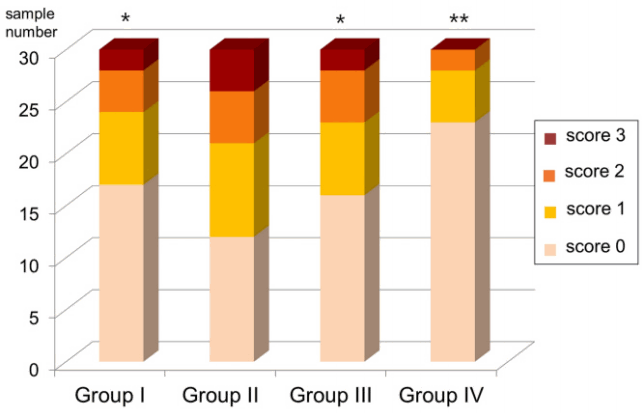
Fig. 6.
SEM images of samples in group I. (A) I-shaped fissure with complete penetration and well adaptation of resin-based sealant. (B) I-shaped fissure with incomplete penetration due to presence of organic material in the fissure (arrow).
E : Enamel, D : Dentin, S : Sealant
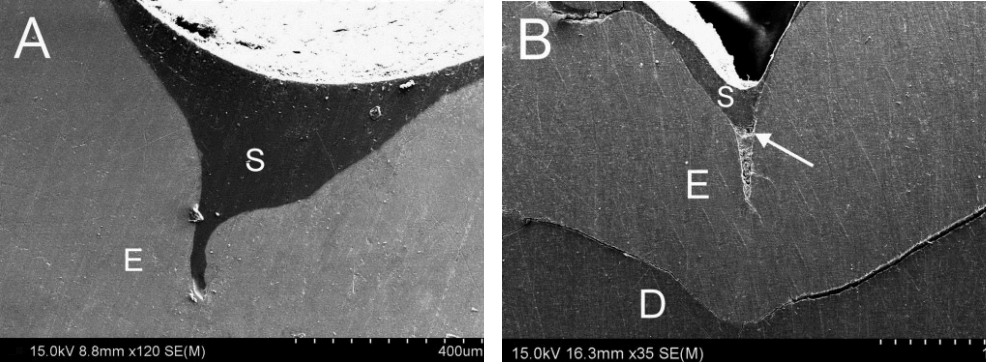
Fig. 7.
SEM images of samples in group II. (A) U-shaped fissure with incomplete penetration of flowable resin. Incomplete adaptation of flowable resin (arrow) to fissure wall was observed. (B) Fissure wall showing incomplete penetration (long arrow) and adaptation (short arrow) of flowable resin.
E : Enamel, D : Dentin, F : Flowable resin

Fig. 8.
SEM images of samples in group III. (A) I-shape fissure with incomplete penetration of flowable resin (arrow). (B) U-shape fissure with complete penetration of flowable resin.
E : Enamel, D : Dentin, F : Flowable resin

Fig. 9.
SEM images of samples in group IV. (A) Fissure with fissurotomy showing complete penetration of flowable resin. (B) Fissure with improper fissurotomy showing incomplete penetration (arrow) of flowable resin.
E : Enamel, F : Flowable resin
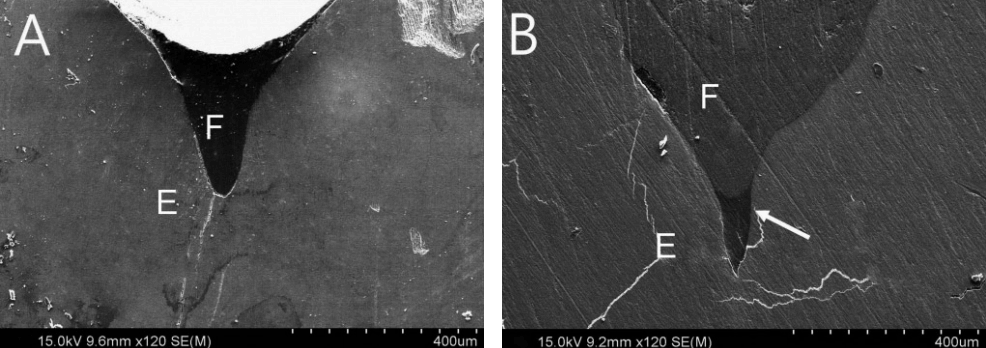
Table 1.
Distribution of samples according to the materials and application methods
| Group | Number | Application method | |
|---|---|---|---|
| Control | I | 30 | Sealant* |
| II | 30 | Flowable resin¶ | |
| Experimental | III | 30 | Bonding agent† + Flowable resin |
| IV | 30 | Fissurotomy + Bonding agent + Flowable resin |
References
1. Jodkowska E : Efficacy of pit and fissure sealing: Long-term clinical observations. Quintesse Int, 39:593-602, 2008.
2. Splieth CH, Ekstrand KR, Alkilzy A : Sealant in dentistry: Outcomes of the ORCA saturday afternoon symposium 2007. Caries Res, 44:3-13, 2010.


3. Wright JT, Tampi MP, Graham L, et al. : Sealants for preventing and arresting pit-and-fissure occlusal caries in primary and permanent molars. Pediatr Dent, 38:282-308, 2016.


4. Lee SH : Retention of pit and fissure sealant. J Korean Acad Pediatr Dent. 33:336-347, 2006.
5. Yilmaz Y, Beldüz N, Eyüboglu OA : Two-year evaluation of four different fissure sealants. Eur Arch Paediatr Dent, 11:88-92, 2010.


6. Reddy VR, Chowdhary N, Mukunda KS, et al. : Retention of resin-based filled and unfilled pit and fissure sealants: A comparative clinical study. Contemp Clin Dent. 6(Suppl 1):S18-23, 2015.



7. Autio-Gold JT : Clinical evaluation of a mediumfilled flowable restorative material as a pit and fissure sealant. Oper Dent, 27:325-329, 2002.

8. Dhar V, Chen H : Evaluation of resin based and glass ionomer based sealants placed with or without tooth preparation-a two year clinical trial. Pediatr Dent, 34:46-50, 2012.

9. Gunjal S, Nagesh L, Raju HG : Comparative evaluation of marginal integrity of glass ionomer and resin based fissure sealants using invasive and non-invasive techniques: an in vitro study. Indian J Dent Res, 23:320-325, 2012.


10. Holmgren C, Gaucher C, Decerle N, et al. : Minimal intervention dentistry II: part 3. Management of non-cavitated (initial) occlusal caries lesions-noninvasive approaches through remineralisation and therapeutic sealants. Br Dent J, 216:237-243, 2014.


11. Chaitra TR, Subba Reddy VV, Devarasa GM, et al. : Flowable resin used as a sealant in molars using conventional, enameloplasty and fissurotomy techniques: an in vitro study. J Indian Soc Pedod Prev Dent, 28:145-150, 2010.


12. Oba AA, Sönmez I, Ercan E, et al. : Comparison of retention rates of fissure sealants using two flowable restorative materials and a conventional resin sealant: two-year follow-up. Med Princ Pract. 21:234-237, 2012.


13. Erdemir U, Sancakli HS, Yaman BC, et al. : Clinical comparison of a flowable composite and fissure sealant: A 24-month split-mouth, randomized, and controlled study. J Dentistry, 42:149-157, 2014.

14. Aguilar FG, Drubi-Filho B, Casemiro LA, et al. : Retention and penetration of a conventional resin-based sealant and a photochromatic flowable composite resin placed on occlusal pits and fissures. J Indian Soc Pedod Prev Dent, 25:169-173, 2007.


15. Jafarzadeh M, Malekafzali B, Tadayon N, Fallahi S : Retention of a Flowable composite resin in comparison to a conventional resin-based sealant: One-year follow-up. J Dent(Tehran). 7:1-5, 2010.


16. Chaitra TR, Subba Reddy W, Ravishankar TL, et al. : Microleakage and SEM analysis of flowable resin used as a sealant following three fissure preparation techniques-An in vitro study. J Clin Pediatr Dent, 35:277-282, 2011.


17. Hevinga MA, Opdam NJ, Truin GJ, et al. : Microleakage and sealant penetration in contaminated carious fissures. J Dent, 35:909-914, 2007.


18. Nagano T : The form of pit and fissure and the primary lesion of caries. Dent Abstract, 6:426, 1960.
19. Gerwal N, Chopra R : The effect of fissure morphology and eruption time on penetration and adaptation of pit and fissure sealants: An SEM study. J Indian Soc Pedod Prevent Dent, 26:59-63, 2008.

20. Banerjee A, Thompson ID, F Watson T : Minimally invasive caries removal using bio-active glass airabrasion. J Dent, 39:2-7, 2011.


21. Kakaboura A, Matthaiou L, Papagiannoulis L : In vitro study of penetration of flowable resin composite and compomer into occlusal fissures. Eur J Paediatr Dent, 3:205-209, 2002.

22. Kucukyilmaz E, Savas S : Evaluation of different fissure sealant materials and flowable composites used as pit-and-fissure sealants: A 24 month clinical trial. Pediatr Dent, 37:468-473, 2015.

23. Duangthip D, Lussi A : Variables contributing to the quality of fissure sealants used by general dental practitioners. Oper Dent, 28:756-764, 2003.

24. Prabhakar AR, Murthy SA, Sugandhan S : Comparative evaluation of the length of resin tags, viscosity and microleakage of pit and fissure sealants-an in vitro scanning electron microscope study. Contemp Clin Dent, 2:324-330, 2011.



25. Beun S, Bailly C, Devaux J, Leloup G : Physical, mechanical and rheological characterization of resin-based pit and fissure sealants compared to flowable resin composites. Dent Mater, 28:349-359, 2012.


26. Burrow MF, Burrow JF, Makinson OF : Pits and fissures: Etch resistance in prismless enamel walls. Aust Dent J, 46:258-262, 2001.


27. Cho TS, Lee SH, Yoon JH, Kim SG : Ultra-structure and etching characteristics of occlusal fissure enamel. J Korean Acad Pediatr Dent, 32:321-331, 2005.
28. Mehrabkhani M, Mazhari F, Sadeghi S, Ebrahimi M : Effects of sealant, viscosity, and bonding agents on microleakage of fissure sealants: An in vitro study. Eur J Dent, 9:558-5, 2015.



29. Feigal RJ, Musherure P, Gillespie B, et al. : Improved sealant retention with bonding agents: a clinical study of two-bottle and single-bottle systems. J Dent Res, 79:1850-1856, 2000.


30. Gillet D, Nancy J, Dupuis V, et al. : Microleakage and penetration depth of three types of materials in fissure sealant: self-etching primer vs etching: an in vitro study. J Clin Pediatr Dent, 26:175-178, 2002.


31. Bagherian A, Akbari M, Rezaeian M, Ansari G : Microleakage assessment of fissure sealant following fissurotomy bur or pumice prophylaxis use before etching. Dent Res J, 10:643-646, 2013.
32. Singla A, Garg S, Jindal SK, et al. : In vitro evaluation of marginal leakage using invasive and noninvasive technique of light cure glass ionomer and flowable polyacid modified composite resin used as pit and fissure sealant. Indian J Dent Res, 22:205-209, 2011.


- TOOLS
-
METRICS

-
- 0 Crossref
- 0 Scopus
- 3,859 View
- 130 Download
- Related articles
-
Evaluation of the Reliability of Salivary Testing Instrument2018 August;45(3)
Quantitative Micro-CT Evaluation of Microleakage in Composite Resin Restorations2007 May;34(2)



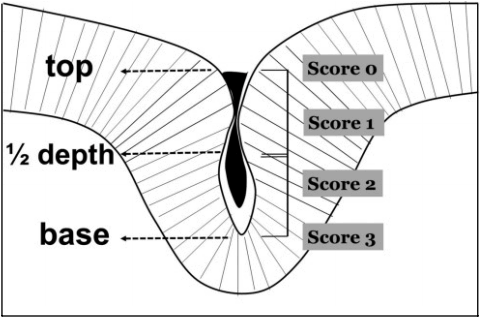
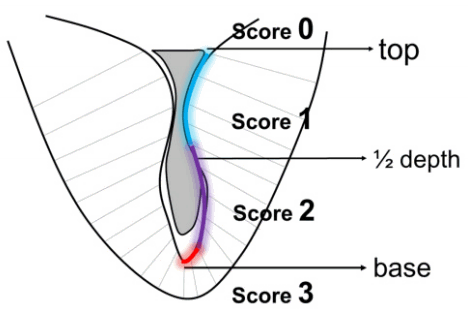
 PDF Links
PDF Links PubReader
PubReader ePub Link
ePub Link Full text via DOI
Full text via DOI Download Citation
Download Citation Print
Print



